
Applications of Generative AI in Digital Commerce Part 1: Content
Generative AI has gained immense interest thanks to the unprecedented success of ChatGPT, the AI chatbot that most of the world has come to love, built by OpenAI. In fact, ChatGPT has become the world's fastest-growing consumer application in history, gaining 100 million users in just 2 months after its launch. So what’s all the fuss about Generative AI, and how can you use it to benefit your digital commerce efforts?
Generative AI is a type of AI that is capable of creating new, original content by learning useful patterns from the massive amount of existing content it was trained on. The content can be in any form: text, audio, images, video, 3D models, or any other form of media. It is able to create or edit content following user instructions, which can be provided in one or several modalities: text prompts, sketches and doodles, sample images, audio snippets, and more. This opens up a whole new range of possibilities for AI-assisted creative content creation.
ChatGPT, in particular, stands on the shoulders of tremendous achievements in natural language processing, ignited by Google’s field-defining Transformer paper, followed by the BERT model which achieved a breakthrough in understanding the complexity of human language. As the size of the models and scale of the training grew by leaps and bounds, they became known as Large Language Models (LLM). One such example is OpenAI GPT3 (2020) which could understand complex prompts, and generate convincing text passages. Open AI ChatGPT represented a step change by extending unsupervised training of base LLM with supervised fine-tuning which helped to produce more natural-sounding sentences. Finally, Reinforcement Learning with Human Feedback (RLHF) helps AI to better choose possible responses. All of this has resulted in a very convincing user experience that has captured the world's imagination.
Similar breakthroughs in image generation include OpenAI’s introduction of DALLE in 2021, which challenged Generative Adversarial Networks (GAN) approach, quickly followed by Midjourney and Stable Diffusion by Stability AI in 2022.
Breakthroughs in other content modalities are happening at a similarly breakneck pace, with new models and capabilities released weekly for music, video, and 3D model generation.
It is no surprise that forward-thinking enterprises are already implementing strategies to optimize their capabilities on the foundation of these models, further tuning them with their proprietary data and creating a wide range of business applications around them.
In this blog series, we will discuss the practical applications of generative AI in the digital commerce industry, starting with how generative AI can be applied in the area of digital commerce content creation, including product images, attributes, creative descriptions, and SEO metadata.
Unlocking the power of Generative AI for product visualization and personalization
In today's digital commerce landscape, product images and videos play a crucial role in shaping the customer experience. Brands and retailers invest heavily in photoshoots featuring stunning human models, lifestyle images set in elaborate environments, creative video production, and cutting-edge 3D rendering - all with the aim of showcasing their products in the most appealing manner possible. However, the significant expenses associated with live photoshoots, the limited quality, and the high costs of 3D renders constrain the scale of these creative efforts and hinder the potential for personalization.
Generative AI has the potential to transform this landscape by streamlining and automating the creative process, as well as unlocking new possibilities for product customization and hyper-personalization.
Let's explore some examples of how generative AI can revolutionize the way products are visually presented.
Streamlining product customization and preview
When shopping for fashion and home decor products, customers are more likely to make a purchase if they have the option to preview items with different colors and patterns of their choosing. However, traditional approaches to providing these options to customers are not ideal. For example, a common practice for retailers is to present color swatches or show images of products in different variations. The problem with this approach is that it can be costly and time-consuming for businesses with many product variations.
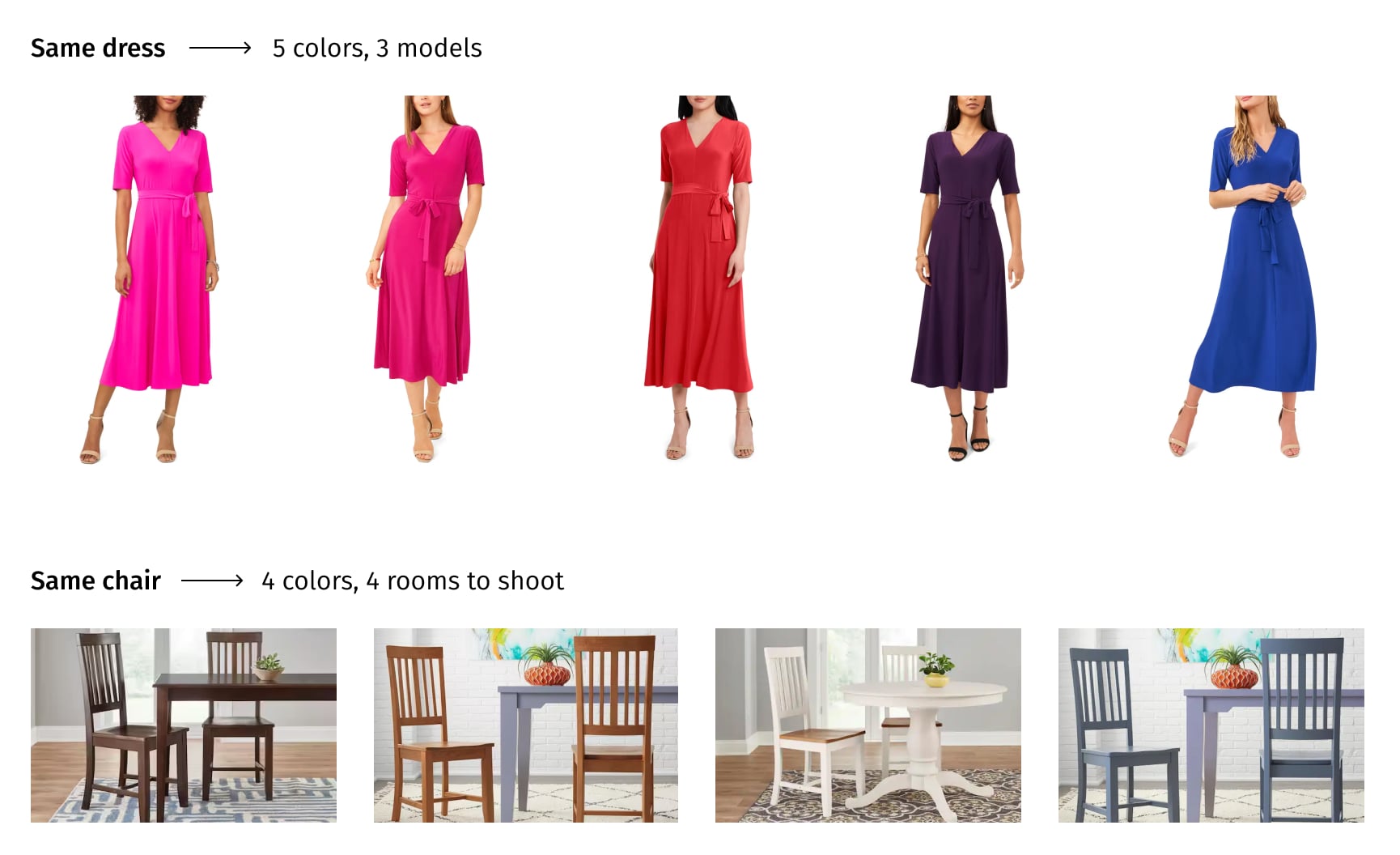
Similarly, in the home improvement industry, 3D modeling is often used to present variations of paints and patterns, but this requires expensive rendering farms, and limits the number of available scenes.
Generative AI solves these problems and simplifies the process by adding the capability to edit images based on textual prompts and doodles. This allows the creation of photo-realistic product previews without physical production, shooting or rendering of the scene. This way, customers can make informed decisions based on accurate visual representations of the product.

Specific color swatches can be added as input to the generative model to support all available colors and patterns.
Scaling creative content with Generative AI product re-contextualization
Generative AI can unlock the creativity of merchandisers and provide a decisive way to improve customer confidence and increase purchase decisions by helping customers visualize how products can fit into their lives. It enables retailers to re-contextualize products in a variety of situations, environments, and scenarios without incurring expensive photo shoot costs.
Customers dream it, generative AI makes it a reality! The Dreambooth paper pioneered the re-contextualization approach by fine-tuning generative AI models using a few images of a product. Although it is still in its early days, it is clear that it carries huge potential, and it is quite certain that it will be perfected soon enough. Many domains, such as fashion, home decor, and beauty will greatly benefit from this innovation.
Below are a few examples generated by fine-tuned Stable Diffusion using the Dreambooth technique:



For some products, instead of fine-tuning the model to achieve full re-contextualization, the generative AI out-painting method also produces stunning results:

This technology can also greatly streamline the creative process for category pages, landing pages, and any other scenario where there is a need for striking hero images featuring real products with specific themes or environments. With re-contextualization, we can quickly develop landing pages tailored to trending search keywords, brands, or events. Generative AI can be prompted to place and style product images for specific themes like Valentine's Day or back-to-school season, enabling the creation of landing pages optimized for those particular occasions.
For example, the following landing page hero image was generated for a “decorative pillows” landing page with a Halloween theme:
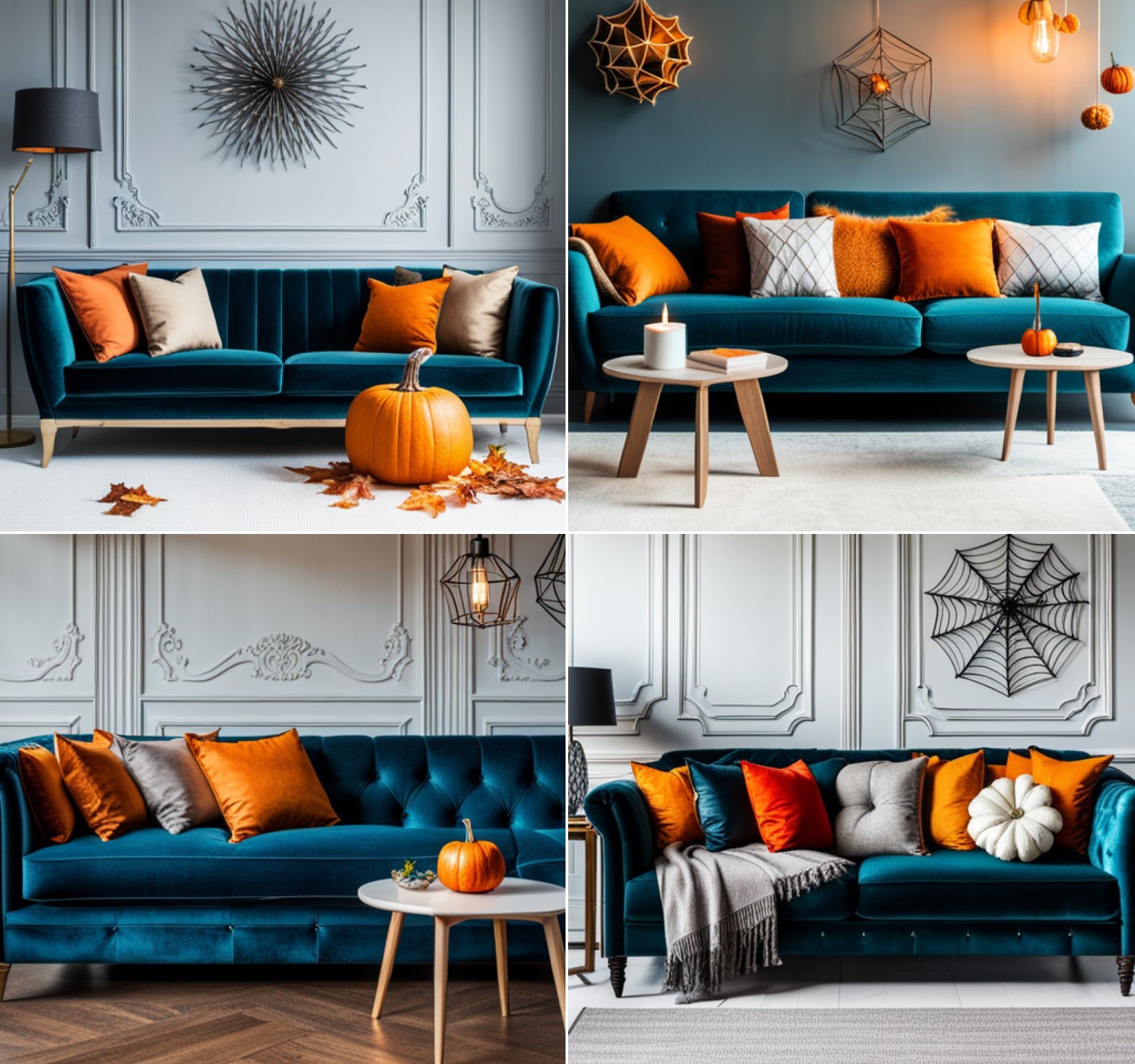
Streamlined creation of landing page content allows businesses to produce and support more content variations, and opens up the road to hyper-personalized landing pages for specific customer segments.
Transforming home decor shopping with Generative AI's realistic scene creation
When shopping for home decor products, customers often want to see what the products will look like in a realistic setting by combining different items. However, retailers currently rely on 3D modeling, which can produce either costly photo-realistic renders or inexpensive, but cartoonish results. This approach also limits the variability of environments and rooms available to the customers, as 3D artists need to create each scene.
Generative AI can provide a solution to this problem by creating realistic scenes that combine products chosen by the customer in an environment specified by a text prompt. This technology enables customers to make informed purchasing decisions by providing them with accurate visual representations of what products look like in a realistic setting.
Below is an example generated by a fine-tuned Stable Diffusion model:

A game-changer for personalized outfit visualizations
Fashion retailers invest heavily in studio and lifestyle images featuring attractive models wearing brand outfits. However, those images typically showcase a limited number of curated outfits due to the high cost of photoshoots. Personalized outfit and "complete-the-look" recommendations are typically not visualized because of the huge number of product combinations. However, increasing customer demand to see outfits in real-life settings worn by relatable individuals is putting pressure on retailers to respond.
Generative AI can answer this demand by creating just-in-time personalized outfit visualizations using virtual models.
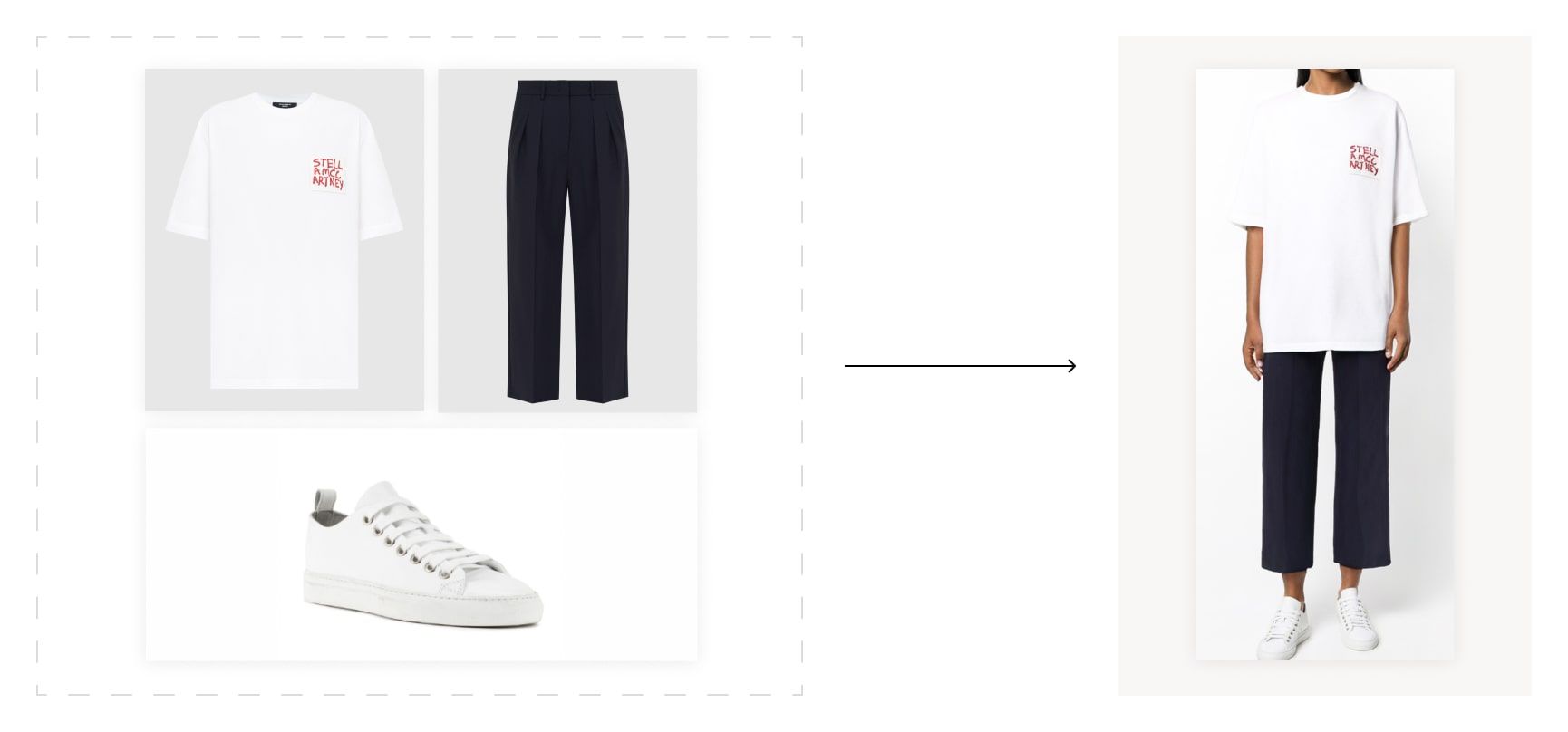
The cost savings associated with virtual models are substantial, as retailers can reduce expenses related to model fees, wardrobe, makeup, and other aspects of real-life photoshoots. But more importantly, virtual models provide unparalleled flexibility, allowing creators to easily adjust and customize the model's appearance, pose, lighting, lens effects, and aperture to align with project requirements.
Furthermore, virtual models present an opportunity to foster inclusivity in the fashion industry by representing a diverse array of ages, body types, and skin tones. This helps break down barriers and promote diversity in an industry often criticized for perpetuating unrealistic beauty standards. By leveraging virtual models, fashion retailers can cultivate a more inclusive and representative image that resonates with a broader spectrum of consumers.

By combining personalized outfit recommendations, virtual models, and product re-contextualization, fashion retailers can generate stunning lifestyle images of outfits that cater to the preferences and expectations of today's discerning customers.
AI twin for personalized virtual try-ons
Taking personalization to the next level, the future of outfit recommendations involves using customers' own images as input for a generative AI model, leading to the creation of a virtual representation known as their "AI twin". While this approach is currently more challenging and relatively expensive to execute accurately, it holds the potential to revolutionize the virtual try-on experience for customers.
Current augmented reality models used for virtual try-ons often deliver subpar quality, resulting in a less-than-satisfactory experience for users. In contrast, "AI twin" virtual try-ons have the potential to provide a far more precise and lifelike representation of how clothing items will fit and appear on customers.
By offering a realistic preview of how garments will look on their AI twins, customers can gain confidence in their choices and avoid post-purchase disappointment. In turn, this helps minimize the likelihood of returns or exchanges, saving both customers and retailers time and resources. As AI technology continues to advance, we can expect "AI twin" virtual try-ons to become increasingly accessible and accurate, ultimately transforming the way customers shop for clothing and accessories online.

Supercharging merchandising content creation
Creative copy and accurate product attribution are crucial in digital commerce. Engaging descriptions capture potential customers' attention and provide essential information, while skillful storytelling evokes emotions and builds trust in a brand. Accurate product attribution streamlines the shopping experience, helping customers quickly discover items based on specific features. Together, compelling copy and precise attribution drive higher conversion rates, increased customer satisfaction, and foster brand loyalty.
Product attribute content generation
Retailers and brands have invested countless hours and millions of dollars into high-fidelity catalog attribution to enable quality search and faceted navigation for enhanced user experience. Still, proper product attribution remains a major challenge for companies, especially marketplaces.
Retailers and brands are spending considerable effort harmonizing attributes and organizing their catalog data for internal consumption, as well as data feeds for 3rd party service providers and partners.
Generative AI can greatly streamline and simplify the attribution process. Text-to-image models can describe the images, while GPT and similar LLMs can process text in product descriptions, customer reviews & FAQ to extract key product attributes.
Next-generation multimodal models, such as GPT4, can ingest product images and product descriptions together, and extract a wide range of attributes from this data.
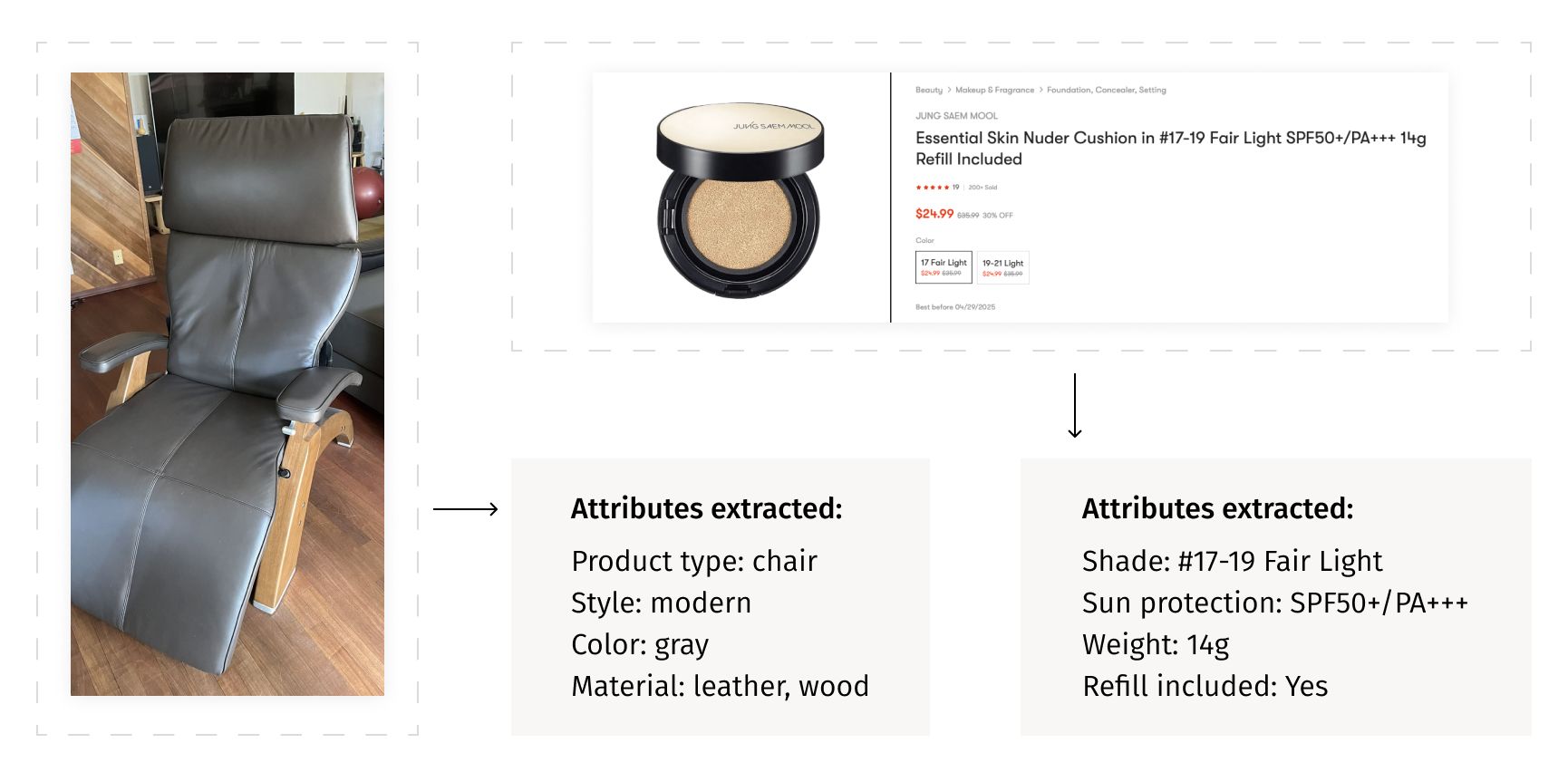
Generating unique and compelling product descriptions
Beyond setting “hard” attributes, such as color and material which typically come from product vendors, merchandisers are pouring massive amounts of effort into creating attractive merchandised product titles and descriptions for the Product Detail Page (PDP). Generative AI, however, is able to convert dry product data into compelling content, as demonstrated below.
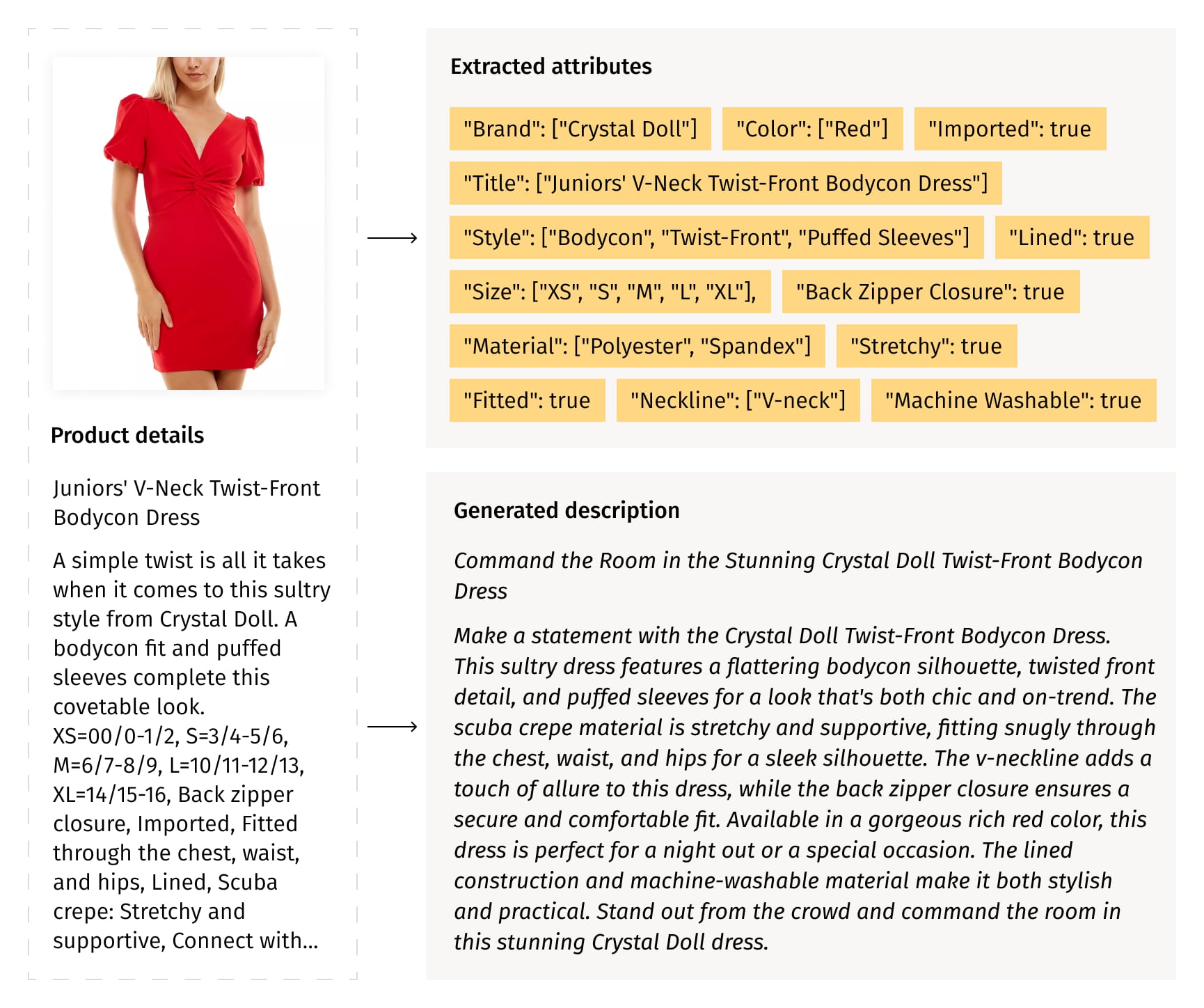
Generative AI can provide a solution to the common issue of machine product description translations that are nearly identical to the original, resulting in harm to SEO rankings. By generating more unique descriptions for each product, this technology can help avoid duplication and improve SEO.
With controllable generation, it becomes possible to generate text in a style that matches with the brand's overall messaging and tone, ensuring consistency across the website's content. Moreover, with slight twists in the prompts, we can make it appealing to different customer segments, achieving effortless personalization:

SEO/SEM metadata
Generative AI is also transforming the field of SEO and SEM. Creating comprehensive and differentiating SEO metadata has always been a challenge that required intensive effort from SEO specialists and merchandisers. Now, you can employ LLMs to generate comprehensive SEO metadata from the product description.
For example, if we provide the product information, and add a prompt, generative AI creates comprehensive metadata for SEO:

FAQ content generation
Another important part of the product page is Frequently Asked Questions (FAQ), where generative AI can create questions and answers based on the product descriptions, and common customer questions. Here is an example of FAQ generated by LLM based on the DeWalt drill product description:
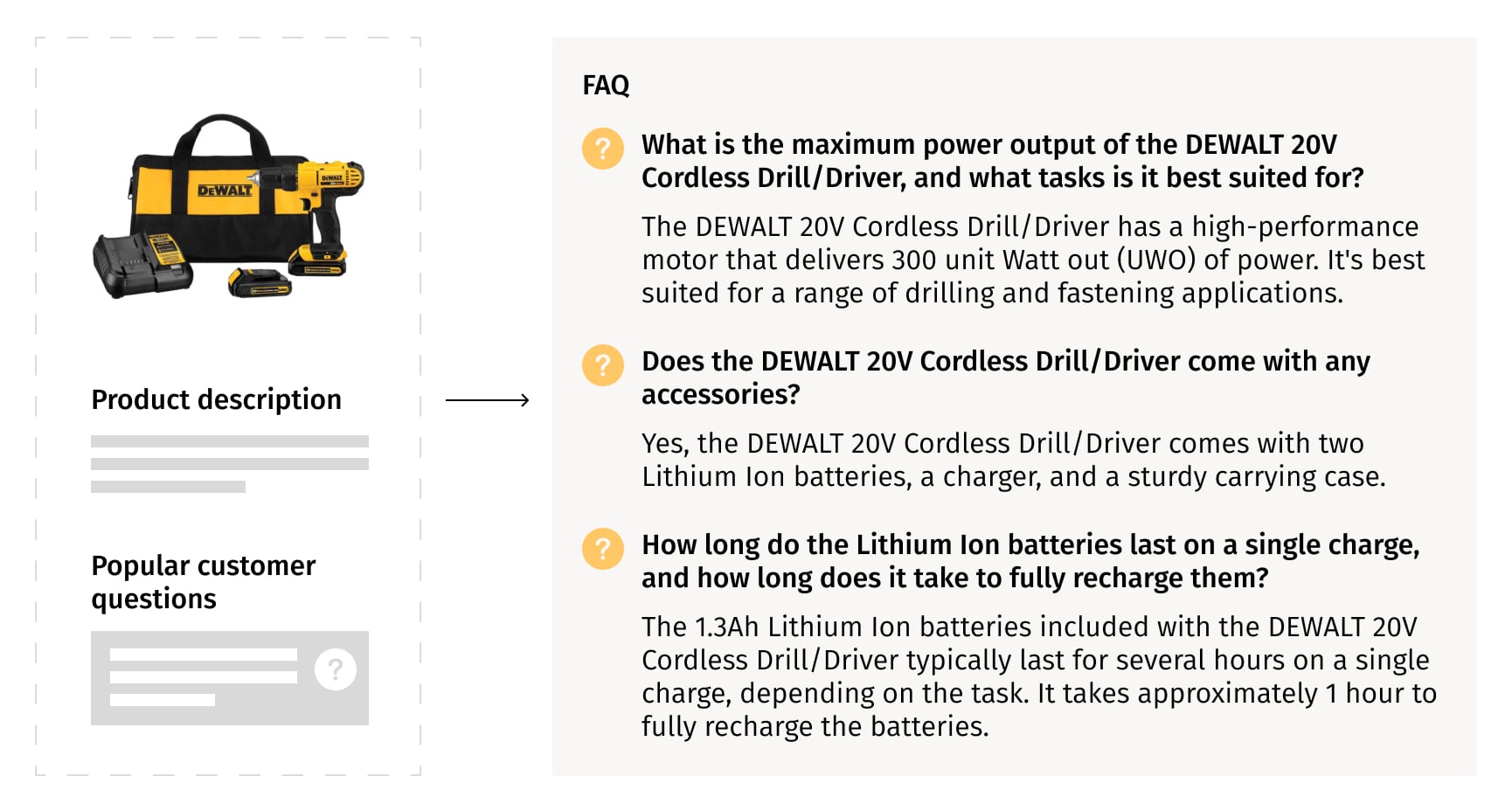
Conclusion
Generative AI is rapidly redefining the digital commerce landscape, unlocking a wealth of possibilities for creative content creation, product visualization, personalization, and merchandising. As businesses tap into the power of generative AI, they are equipped to deliver more captivating and tailored experiences to their customers, streamline processes, and amplify engagement across the board.
From generating realistic product previews and re-contextualizing products in various scenarios, to simplifying product attribution and crafting optimized SEO metadata, generative AI is leaving its mark across an array of domains. As the technology evolves further, we can anticipate even more advanced applications that will help businesses stay ahead of the curve in the fast-paced digital commerce environment.
Stay tuned for the second part of the series, where we will delve deeper into the applications of generative AI in enhancing customer experience in digital commerce. We will explore how this transformative technology improves product search, product research and selection, and unlocks the power of self-service product customization.
Get in touch with us to start a conversation about generative AI for your business.

